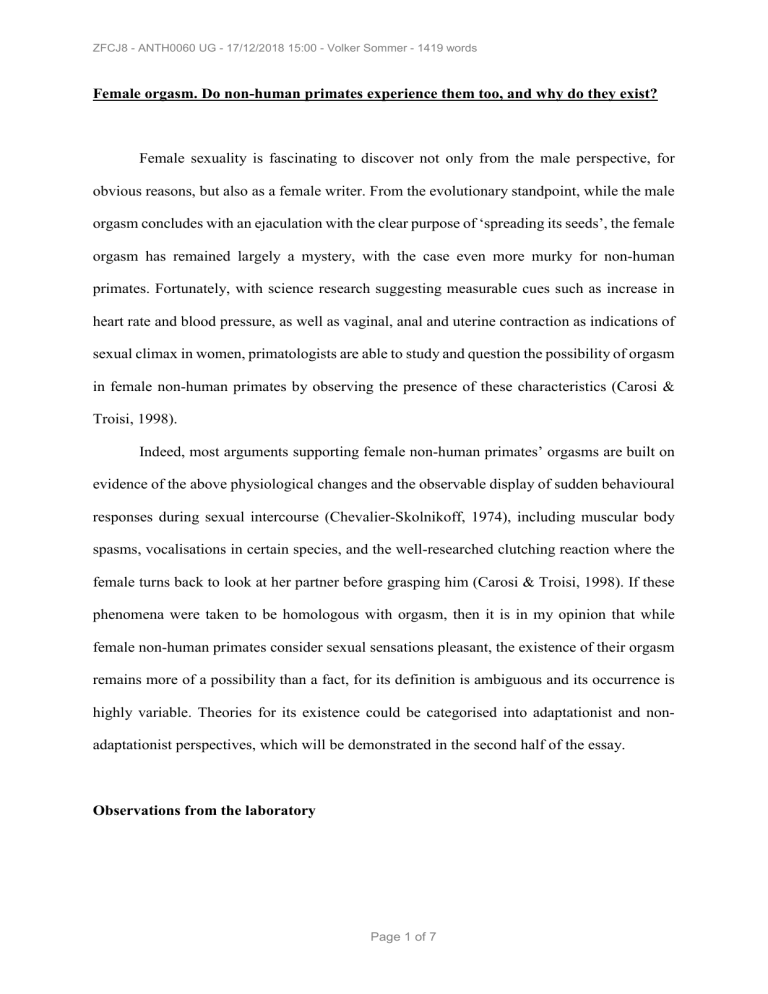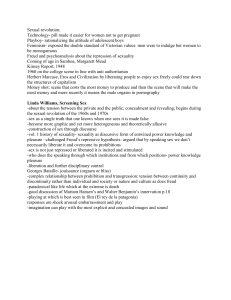
ZFCJ8 - ANTH0060 UG - 17/12/2018 15:00 - Volker Sommer - 1419 words
Female orgasm. Do non-human primates experience them too, and why do they exist?
Female sexuality is fascinating to discover not only from the male perspective, for
obvious reasons, but also as a female writer. From the evolutionary standpoint, while the male
orgasm concludes with an ejaculation with the clear purpose of ‘spreading its seeds’, the female
orgasm has remained largely a mystery, with the case even more murky for non-human
primates. Fortunately, with science research suggesting measurable cues such as increase in
heart rate and blood pressure, as well as vaginal, anal and uterine contraction as indications of
sexual climax in women, primatologists are able to study and question the possibility of orgasm
in female non-human primates by observing the presence of these characteristics (Carosi &
Troisi, 1998).
Indeed, most arguments supporting female non-human primates’ orgasms are built on
evidence of the above physiological changes and the observable display of sudden behavioural
responses during sexual intercourse (Chevalier-Skolnikoff, 1974), including muscular body
spasms, vocalisations in certain species, and the well-researched clutching reaction where the
female turns back to look at her partner before grasping him (Carosi & Troisi, 1998). If these
phenomena were taken to be homologous with orgasm, then it is in my opinion that while
female non-human primates consider sexual sensations pleasant, the existence of their orgasm
remains more of a possibility than a fact, for its definition is ambiguous and its occurrence is
highly variable. Theories for its existence could be categorised into adaptationist and nonadaptationist perspectives, which will be demonstrated in the second half of the essay.
Observations from the laboratory
Page 1 of 7
ZFCJ8 - ANTH0060 UG - 17/12/2018 15:00 - Volker Sommer - 1419 words
Despite a general paucity of data recording the sexual responses of non-human
primates, there is nonetheless enough information to at least conclude that they do, certainly,
enjoy genital stimulation (Lemmon & Allen, 1978). Allen (1977), for instance, conducted a
research on female chimpanzees through manually stimulating their circumclitoral area and
vagina. The majority allowed stimulation to proceed to sexual arousal. One even allowed
stimulation to vaginal contractions on ten independent occasions, always terminating
stimulations and leaving quadrupedally after the vaginal contractions had stopped (ibid., 1977).
In an interesting case, a female turned back and attempted to push the experimenter’s thrusting
hand deeper into her vagina (ibid., 1977). The same female did not discontinue stimulation
while she was experiencing vaginal contractions on two separate occasions as her infant tried
to intervene the process, in comparison to similar occurrences of meddling during earlier stages
where she initiated the termination of stimulation, indicating that she was experiencing some
form of exceptional pleasure which could be an indication of orgasm (ibid., 1977). In addition
to enjoyment, other physiological changes observed across the chimpanzees in this study
included hyperventilation, clitoral tumescence, reflexive spasms in the limbs with muscle
tension, or changes in facial expressions, which are also typical reactions found in women
during orgasm, suggesting a possibility of orgasm in female non-human primates (ibid., 1977).
Chevalier-Skolnikoff (1974), too, in a study of female stumptails found behaviours
homologous to the orgasmic phenomenon of male stumptails, which he argues are responses
fundamentally identical to those reported by Masters and John (1966) in women and hence
supports the argument for female non-human primates’ orgasm. Common observations across
these stumptails included the clutching reaction and the postejaculatory phase where the sexual
partners engaged in mutual grooming and close physical contact (ibid., 1974). Among female
homosexual interactions, it was noticed on three independent events that the mounter displayed
all the behavioural signals found in males during sexual climax: body rigidity and muscular
Page 2 of 7
ZFCJ8 - ANTH0060 UG - 17/12/2018 15:00 - Volker Sommer - 1419 words
body spasms were accompanied with a pause and the distinctive “frowning round-mouthed
stare expression” (ibid., 1974: 109) and rhythmic vocalisation.
Although these evidence — consisting mainly of physiological behavioural responses
— reflect that female non-human primates find genital stimulation pleasurable, and show
characteristics comparable to the orgasmic experiences of male primates and human female,
there are limitations to what can be interpreted from this data. Firstly, they are limited to
artificial social situations, often in laboratories, which make theorising difficult (Phoebus,
1982). Secondly, there is no definite proof that these physiological changes can be equated to
a subjective experience of orgasm as found in those of women’s sexual climaxes (Carosi &
Troisi, 1998). For example, few emotional responses, such as blatant vocalisation which are
common among women, could be noticed during intense vaginal contractions and strong
palpitation (Allen, 1977). Hence, I hold that the existence of orgasm in female non-human
primates remains debatable, albeit the case for it is strong.
Adaptationist versus Anti-adaptationist
More significantly, the female non-human primates’ orgasm — or the lack thereof —
is tied to a broader narrative of its raison d’être. Combining theories from the evolution of the
orgasm in human females, explanations for its existence can be categorised as adaptationist
(Lemmon & Allen, 1981; Morris, 1967; Hrdy, 1981; Carosi & Troisi, 1998) or nonadaptationist (Symons, 1979).
Lemmon and Allen (1981) contends that the orgasmic response of females in mammals
has evolved to trigger the orgasmic response in males, through observation that contractions of
the perivaginal muscles productively grip and stimulate the penis which encourages
ejaculation. Also from the perspective in relation to the male counterpart, Morris argues the
Page 3 of 7
ZFCJ8 - ANTH0060 UG - 17/12/2018 15:00 - Volker Sommer - 1419 words
female orgasm “[makes] sex sexier” (1967: 65). It functions as a behavioural reward to
condition the female into availing herself whenever her partner solicited sex, enhancing the
“pair-bond” (ibid., 1967: 38) between them and thus enabling females to secure from their
partners the greater parental investment needed as a consequence of modern humans’ longer
life history and longer juvenile period. For Morris, orgasms facilitate monogamy (ibid., 1967).
On the other hand, while Hrdy (1981) likewise construes the female orgasm as a
behavioural reward, for him it facilitates promiscuity instead. A ‘promiscuous’ female primate
that strives to copulate with as many partners enjoy a selective advantage for two reasons (ibid.,
1981). Firstly, it allows the female to assess the “capabilities” (ibid., 1981: 150) of each and so
strategise to mate with the strongest and fittest when it ovulates. Secondly, it is beneficial to its
offspring as it could protect them from infanticide and possibly lead to multiple partners
involving themselves in their care since the paternity of its babies are ambiguous (ibid., 1981).
Similar to Hrdy (1981), Carosi and Troisi (1998) makes the link between female orgasm
and mate choice, arguing for the former as an adaptation which evolutionary purpose is the
latter. Their finding that male rank influences the likelihood of orgasmic-like responses in
female suggests that physical stimulation is not the only variable affecting female sexual
arousal: social stimuli is a non-negligible factor too (ibid., 1998). Supporting their claim is
previous research that female macaque occasionally displays keen sexual liking for
unacquainted males who are new to the community, counteracting preferences for fitter and
high-status resident males (Takahata, 1982).
Of the four adaptationist theories attempting to account for the female orgasm’s raison
d’être, the first two presented (Lemmon & Allen, 1981; Morris, 1967) reduce to the ontological
claim that female orgasm is a natural phenomenon. Subsequently, the next two arguments
(Hrdy, 1981; Carosi & Troisi, 1998), which associates female orgasm with mate choice, see
the female orgasm as belonging to the domain of culture instead.
Page 4 of 7
ZFCJ8 - ANTH0060 UG - 17/12/2018 15:00 - Volker Sommer - 1419 words
Symons (1979), who proposes that the female orgasm is a byproduct of the evolutionary
advantage orgasms have on males, recognise that orgasms are as cultural as “agriculture, the
wheel, and indoor plumbing” (1979: 95). Her non-adaptationist view, unlike in the previous
reasonings presented, sees the female orgasm as serving no adaptive function, similar to the
clitoris which has no known purpose apart from a source of great sensation that is “presumably
pleasure” (ibid., 1979: 88). She supports this by drawing an analogy with the widely-cited
example of male nipples (ibid., 1979).
Female representation; Female orgasm
Notably, there is no one agreed conclusion to the purpose of the female orgasm, whether
in humans or non-human primates. Theories can be as diverse as ranging from adaptationists
versus non-adaptationists as explained above, to anthropocentrists versus antianthropocentrists,
which is a debate embedded in the broader feminist movement (Bosley, 2010). What can be
agreed on, however, is that the female is not passive in sex: in Lemmon and Allen (1981), it
suggests the male orgasm follows the lead of the female orgasm. In Morris (1967), it shows
females know how to fight for greater parental investment. In both Hrdy (1981) and Carosi and
Troisi (1998), similarly, mate choice reflects that women (or female primates) are not
powerless in the game of relationships.
And, ultimately, with more women power and female representation, maybe then can
we someday find out if female non-human primates indeed experience orgasms.
Page 5 of 7
ZFCJ8 - ANTH0060 UG - 17/12/2018 15:00 - Volker Sommer - 1419 words
Bibliography
Allen, M. L. & Lemmon, W. B. 1978. Continual sexual receptivity in the female chimpanzee
(Pan troglodytes). In: Folia Primatologica, 30: 80-88.
Allen, M. L. & Lemmon, W. B. 1981. Orgasm in female primates. In: American Journal of
Primatology, 1: 15-34.
Bosley, J. 2010. Monkey facts to human ideologies: Theorising female orgasm in human and
nonhuman primates, 1967-1983. In: The University of Chicago Press Journals, 35(3): 647671.
Carosi, M. & Troisi, A. 1998. Female orgasm rate increases with male dominance in
Japanese macaques. In: Animal Behaviour, 56: 1261-1266.
Chevalier-Skolnikoff, S. 1974. Male-female, female-female, and male-male sexual behaviour
in the stumptail monkey, with special attention to the female orgasm. In: Archives of Sexual
Behaviour, 3(2): 95-116.
Hrdy, S. B. 1981. The woman that never evolved. Cambridge, MA: Harvard University Press.
Morris, D. 1967. The naked ape: A zoologist’s study of the human animal. New York:
McGraw-Hill.
Page 6 of 7
ZFCJ8 - ANTH0060 UG - 17/12/2018 15:00 - Volker Sommer - 1419 words
Phoebus, E. C. 1982. Letter: Primate female orgasm. In: American Journal of Primatology, 2:
223-224.
Symons, D. 1979. The evolution of human sexuality. Oxford: Oxford University Press.
Takahata, Y. 1982. The socio-sexual behaviour of Japanese monkeys. In: Zeitschrift fu ̈r
Tierpsychologie, 59: 89-108.
Page 7 of 7





